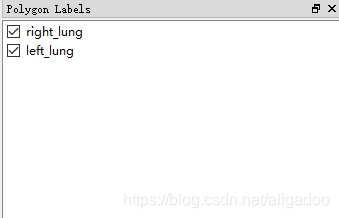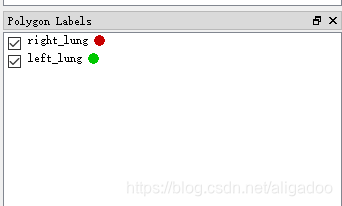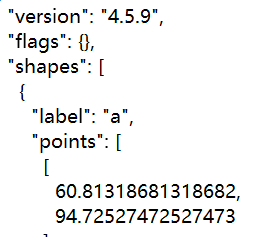使用labelme做多分类分割数据集(遇到的各种问题和解决办法)
这两天为了给医学图像做多分类分割又折腾了很久的labelme,因为之前做的是简单的二分类问题,而且也是瞎捣鼓的能解决当时的问题就行了。这次却遇到了很多之前没遇到的问题,也了解了一些东西,特此记录下来因为我感觉我睡一晚上就会忘了。
关于labelme的版本问题
关于labelme安装过程,这里就不详细讲了基本上所有相关博客都有讲。3.xx和4.xx的版本主要在标注的显示和生成的json文件上有差别。

version-3.16.5

version-4.5.9

- List item

批量转换json、生成的label一片黑、图像位深不是8bit以及多分类中相同类别label颜色不一致
在我使用的过程中,感觉高版本中网上的批量转换json文件的json_to_dataset.py,生成的label是黑的,位深是16位,当然应该是可调的,全黑因为mask填充的像素值很低基本看不出来。算了不讲废话了我的最终程序如下:
下面展示一些 内联代码片。
import argparse
import json
import os
import os.path as osp
import warnings
import PIL.Image
import yaml
from labelme import utils
import base64
def main():
warnings.warn("This script is aimed to demonstrate how to convert the\n"
"JSON file to a single image dataset, and not to handle\n"
"multiple JSON files to generate a real-use dataset.")
parser = argparse.ArgumentParser()
parser.add_argument('json_file')
parser.add_argument('-o', '--out', default=None)
args = parser.parse_args()
json_file = args.json_file
if args.out is None:
out_dir = osp.basename(json_file).replace('.', '_')
out_dir = osp.join(osp.dirname(json_file), out_dir)
else:
out_dir = args.out
if not osp.exists(out_dir):
os.mkdir(out_dir)
count = os.listdir(json_file)
for i in range(0, len(count)):
path = os.path.join(json_file, count[i])
filename = count[i][:-5]
if os.path.isfile(path):
data = json.load(open(path))
if data['imageData']:
imageData = data['imageData']
else:
imagePath = os.path.join(os.path.dirname(path), data['imagePath'])
with open(imagePath, 'rb') as f:
imageData = f.read()
imageData = base64.b64encode(imageData).decode('utf-8')
img = utils.img_b64_to_arr(imageData)
# label_name_to_value = {'_background_': 0}
# for shape in data['shapes']:
# label_name = shape['label']
# if label_name in label_name_to_value:
# label_value = label_name_to_value[label_name]
# else:
# label_value = len(label_name_to_value)
# label_name_to_value[label_name] = label_value
label_name_to_value = {'_background_': 0,
'right': 1,
'left': 2}
# label_values must be dense
label_values, label_names = [], []
for ln, lv in sorted(label_name_to_value.items(), key=lambda x: x[1]):
label_values.append(lv)
label_names.append(ln)
assert label_values == list(range(len(label_values)))
lbl = utils.shapes_to_label(img.shape, data['shapes'], label_name_to_value)
captions = ['{}: {}'.format(lv, ln)
for ln, lv in label_name_to_value.items()]
lbl_viz = utils.draw_label(lbl, img, captions)
out_dir = osp.basename(count[i]).replace('.', '_')
out_dir = osp.join(osp.dirname(count[i]), out_dir)
if not osp.exists(out_dir):
os.mkdir(out_dir)
PIL.Image.fromarray(img).save(osp.join(out_dir, 'img.png'))
# PIL.Image.fromarray(lbl).save(osp.join(out_dir, 'label.png'))
utils.lblsave(osp.join(out_dir, 'label.png'), lbl)
PIL.Image.fromarray(lbl_viz).save(osp.join(out_dir, 'label_viz.png'))
with open(osp.join(out_dir, 'label_names.txt'), 'w') as f:
for lbl_name in label_names:
f.write(lbl_name + '\n')
warnings.warn('info.yaml is being replaced by label_names.txt')
info = dict(label_names=label_names)
with open(osp.join(out_dir, 'info.yaml'), 'w') as f:
yaml.safe_dump(info, f, default_flow_style=False)
print('Saved to: %s' % out_dir)
if __name__ == '__main__':
main()
labelme本身没有注意到生成标签一一对应的问题,一开始的时候我还在draw.py里面去该颜色的映射关系后来发现直接把label_name_to_vaule这一段注释掉改成自己想要对应的标签即可。
最后的小注意,如果遇到如下报错一般要查看labelme安装路径下utils中是否缺少draw.py,没有需要补上,然后在同样路径下的_init_.py文件下添加导入包的代码。
ModuleNotFoundError: No module named 'labelme.utils.draw' #报错1
AttributeError: module 'labelme.utils' has no attribute 'draw_label' #报错2
解决报错1
import io
import numpy as np
import PIL.Image
import PIL.ImageDraw
def label_colormap(N=256):
def bitget(byteval, idx):
return (byteval & (1 << idx)) != 0
cmap = np.zeros((N, 3))
for i in range(0, N):
id = i
r, g, b = 0, 0, 0
for j in range(0, 8):
# if i == 1:
# r = 255;
# g = 255;
# b = 255;
# else:
# r = np.bitwise_or(r, (bitget(id, 0) << 7 - j))
# g = np.bitwise_or(g, (bitget(id, 0) << 7 - j))
# b = np.bitwise_or(b, (bitget(id, 0) << 7 - j))
r = np.bitwise_or(r, (bitget(id, 0) << 7 - j)) # bitwise_or()函数对数组中整数的二进制形式执行位或运算
g = np.bitwise_or(g, (bitget(id, 1) << 7 - j)) # bitget(a,b),获取二进制数a的第b位值
b = np.bitwise_or(b, (bitget(id, 2) << 7 - j))
id = (id >> 3)
cmap[i, 0] = r
cmap[i, 1] = g
cmap[i, 2] = b
#
# cmap[1, :] = [255,0,0]
# cmap[2, :] = [0,255,0]
cmap = cmap.astype(np.float32) / 255
return cmap
# similar function as skimage.color.label2rgb
def label2rgb(lbl, img=None, n_labels=None, alpha=0.5, thresh_suppress=0):
if n_labels is None:
n_labels = len(np.unique(lbl))
cmap = label_colormap(n_labels)
cmap = (cmap * 255).astype(np.uint8)
lbl_viz = cmap[lbl]
lbl_viz[lbl == -1] = (0, 0, 0) # unlabeled
if img is not None:
img_gray = PIL.Image.fromarray(img).convert('LA')
img_gray = np.asarray(img_gray.convert('RGB'))
# img_gray = cv2.cvtColor(img, cv2.COLOR_RGB2GRAY)
# img_gray = cv2.cvtColor(img_gray, cv2.COLOR_GRAY2RGB)
lbl_viz = alpha * lbl_viz + (1 - alpha) * img_gray
lbl_viz = lbl_viz.astype(np.uint8)
return lbl_viz
def draw_label(label, img=None, label_names=None, colormap=None):
import matplotlib.pyplot as plt
backend_org = plt.rcParams['backend']
plt.switch_backend('agg')
plt.subplots_adjust(left=0, right=1, top=1, bottom=0,
wspace=0, hspace=0)
plt.margins(0, 0)
plt.gca().xaxis.set_major_locator(plt.NullLocator())
plt.gca().yaxis.set_major_locator(plt.NullLocator())
if label_names is None:
label_names = [str(l) for l in range(label.max() + 1)]
if colormap is None:
colormap = label_colormap(len(label_names))
label_viz = label2rgb(label, img, n_labels=len(label_names))
plt.imshow(label_viz)
plt.axis('off')
plt_handlers = []
plt_titles = []
for label_value, label_name in enumerate(label_names):
if label_value not in label:
continue
if label_name.startswith('_'):
continue
fc = colormap[label_value]
p = plt.Rectangle((0, 0), 1, 1, fc=fc)
plt_handlers.append(p)
plt_titles.append('{value}: {name}'
.format(value=label_value, name=label_name))
plt.legend(plt_handlers, plt_titles, loc='lower right', framealpha=.5)
f = io.BytesIO()
plt.savefig(f, bbox_inches='tight', pad_inches=0)
plt.cla()
plt.close()
plt.switch_backend(backend_org)
out_size = (label_viz.shape[1], label_viz.shape[0])
out = PIL.Image.open(f).resize(out_size, PIL.Image.BILINEAR).convert('RGB')
out = np.asarray(out)
return out
解决报错2
from .draw import label_colormap
from .draw import label2rgb
from .draw import draw_label







 本文记录了使用labelme进行多分类图像分割时遇到的问题,包括批量转换json文件生成黑色label、图像位深问题以及相同类别label颜色不一致等。作者提供了修改后的代码示例,解决了这些问题,并提醒注意labelme版本差异。此外,还提到了可能出现的导入错误及其解决方法。
本文记录了使用labelme进行多分类图像分割时遇到的问题,包括批量转换json文件生成黑色label、图像位深问题以及相同类别label颜色不一致等。作者提供了修改后的代码示例,解决了这些问题,并提醒注意labelme版本差异。此外,还提到了可能出现的导入错误及其解决方法。
















 5683
5683

 被折叠的 条评论
为什么被折叠?
被折叠的 条评论
为什么被折叠?








